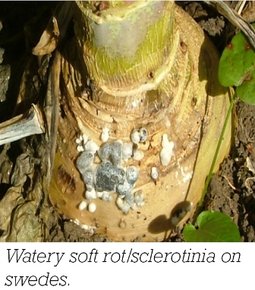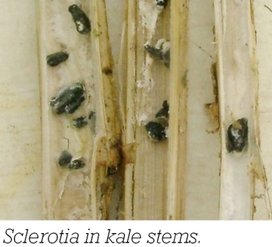Sclerotinia (SC)
SC, also known as watery soft rot, is a fungal pathogen with a wide range of hosts including all brassicas. Infection occurs from air-borne spores or from over-wintering sclerotia (dormant survival spores) in the soil.
Identification
SC is characterised by a soft watery rot of stems and bulbs. It produces extensive white mycelium under humid, wet conditions, and black overwintering sclerotia develop on and in the diseased tissue.

Importance
n many crops, only scattered infected plants are seen. But SC can build up in areas where consecutive susceptible crops are used.
Spread
Sclerotinia can survive in the soil for up to 20 years, and spread by physical contact with infected tissues. Thus patches of infection can occur in dense moist crops. Sclerotia are often the same size and shape as brassica seeds, so contaminated lines can account for introduction into a crop.
Prevention and management
Sowing certified disease free seed along with good crop rotations minimises SC. Good cultivation is also essential, to ensure that crop debris is broken down and out of the planting zone when re-sowing into crop.


